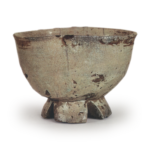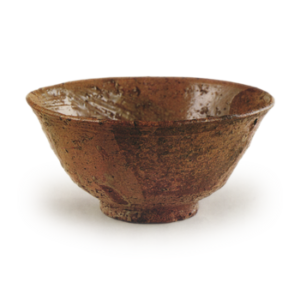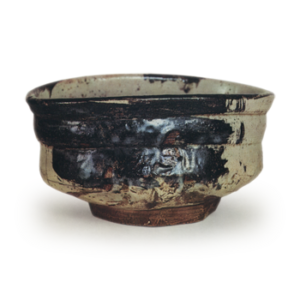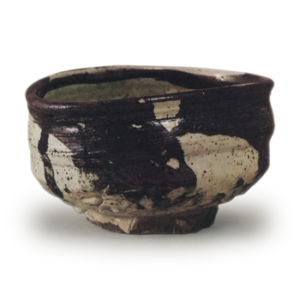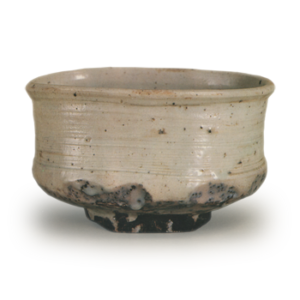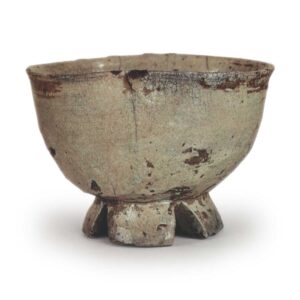
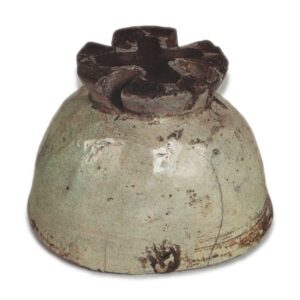
Held in the Hatakeyama Memorial Museum
Height: 9.4 – 9.7 cm
Diameter: 12.8 – 13.4 cm
Outer diameter of foot ring: 7.8 cm
Height of foot ring: 2.0 – 2.3 cm
This is a famous bowl with a cracked foot ring that was once owned by the Konoike family of Osaka. As is written in the “Tea Ceremony Tradition” (“Sadō Shōden-shū”), “There are many different types of foot ring”, and the foot rings of the waribata type are made in a variety of ways. The waribata foot ring of the Wakasu Sakai family (a famous tea utensil), the waribata foot ring of the Yanagi-ei family (a famous tea utensil), the waribata foot ring of the Unshu Matsudaira family (a famous tea utensil), the waribata foot ring of the Iyo Hisamatsu family (a famous tea utensil), the waribata foot ring of the Himeji Sakai family (a famous tea utensil), the waribata foot ring of the Himeji Sakai family (a famous tea utensil), the waribata foot ring of the Himeji Sakai family (a famous tea utensil), the waribata foot ring of the Himeji Sakai family (a famous tea utens , the “Toan” waribata of the Matsuura family of Hirado, and the “Nakachigai” waribata in the collection of Mr. Yoshio Takahashi, none of them are the same. This waribata, which was passed down in the Konoike family, is particularly large and strong, and its style of manufacture is different from that of other waribata.
Some waribata tea bowls, such as those of the Wakasu Sakai family, have a body similar to that of a well-made earthenware bowl, but most are made of a slightly iron-rich porcelain material, which is commonly referred to as “hard-handled”. This waribata tea bowl is also made of this material.
The light gray unglazed body is similar to porcelain in color, but it has a coarse crackle finish and a slightly earthy feel, and is a hard-fired body that is commonly referred to as semi-porcelain. This is covered in a thick layer of transparent white glaze with a slight iron content on the inside, outside and bottom. It is well-fired and glossy, and the thick parts of the glaze have a slight bluish tinge.
It was made on a potter’s wheel, but the mouth was distorted into a round shape by spinning it from two sides, and the waist was roughly scraped with a spatula, giving it a somewhat handmade, soft feel.
The first thing that catches the eye when you look at this teacup is the large, sturdy foot ring with its full skirt. This was made by first shaping the bottom flat on the potter’s wheel, then adding a spatula to the four sides of the foot ring to split it into a cross shape, and then carving out a cross-shaped hole in the center. If you look closely at the cross-shaped mark in the center, you will see that it was made by drawing a line after firing, and that the ochi-dashi was added later. Of the various types of foot ring, the construction is particularly unusual, and I have never seen a bowl with such a strong, sturdy foot ring before. There are eight marks on the foot ring. The firing was slightly reductive, and the glaze is tinged with a light blue, but the waist of the bowl is also slightly pink.
There is a crack that extends from the rim to the interior of the bowl, but it then forms a ring around the interior. Looking at the way it has cracked, it seems to have been broken in two by boiling water, in the same way as the Mitsui family’s celadon horse-shaped kettle. There are also two other kettles of various sizes, but as they are made of porcelain, they are not frayed.
The accessories are a black lacquered inner box, a paulownia wood inner box, and a paulownia wood outer box. On the front is the inscription “Wari Takadai ga mo yo (signature)”. On the back, there is a note written by the priest Goga Osho, which says “Rikyu Hyakue ni yō yū den’ō (signature)”, and in the “Konoike Zōchō” (Konoike’s account book) it says “Rikyu Hyakue □ ren, omoshiroki mono ya (Rikyu Hyakue series, interesting things)”. However, it is not recorded in the “Rikyu Hyakueki” (Rikyu Hyakue record), and it is unknown whether this tea bowl was used in the Rikyu Hyakue.
It is said that it was originally owned by Furuta Oribe, and then passed to the Kyoto physician Imakoji Michizou, and then to Ishikawa Souun, the lord of Inuyama Castle in Bishu. It is said that it was then sold by the Ishikawa family to Tama-ya Ihei and Shoubei, and then passed to the Konoike family.
In 1942, Mr. Hatakeyama Kazukiyo acquired it through a tender by the Konoike family, and it is currently in the collection of the Hatakeyama Memorial Museum. It is listed in the Taisho Meiki Kan.

